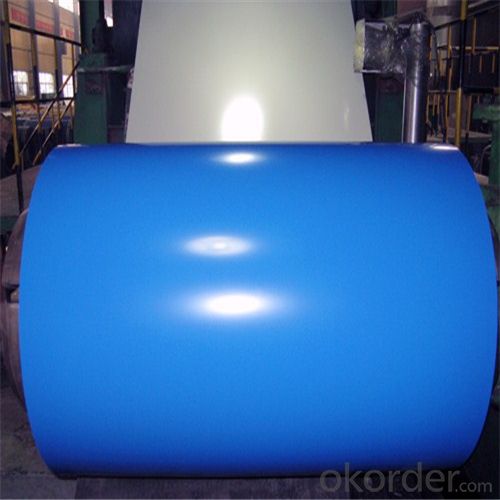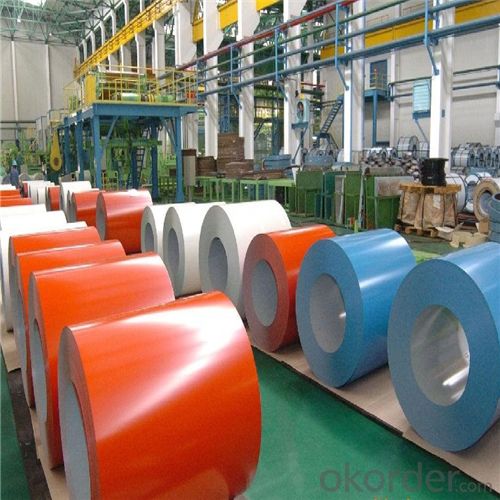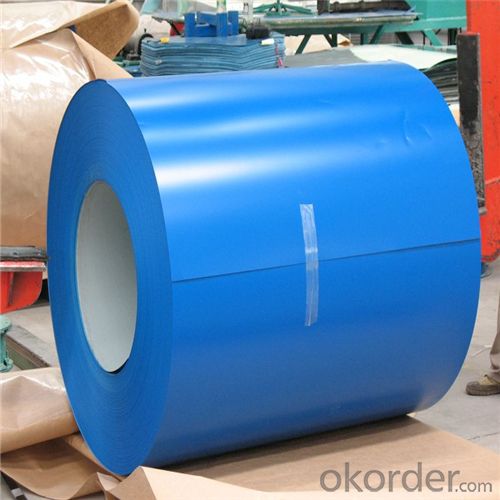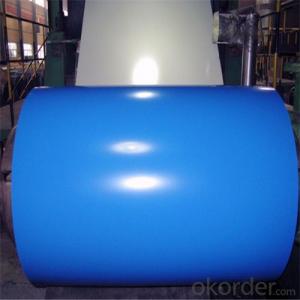Pre-painted Galvanized Steel Coil Used for Industry with the Attractive Good Price
- Loading Port:
- Shanghai
- Payment Terms:
- TT OR LC
- Min Order Qty:
- 25 m.t.
- Supply Capability:
- 5000 m.t./month
OKorder Service Pledge
OKorder Financial Service
You Might Also Like
Pre-painted Galvanized Steel Coil Used for Industry
1.Structure of Pre-painted Galvanized Steel Coil Description
With GI as base metal, after pretreatement and liquid dope with several layers of color, then after firing and cooling, finally the plate steel is called pre-painted galvanized steel. Pre-painted galvanized steel is good capable of decoration, molding, corrosion resistance. It generally displays superior workability, durability and weather resistance.
2.Main Features of Pre-painted Galvanized Steel Coil
•High Purity
•Easy control and operation
•High strength
•Fast melting
•Competitive price
•Best Service
3. Pre-painted Galvanized Steel Coil Images



4. Pre-painted Galvanized Steel Coil Specification
Pre-painted Galvanized Steel Coil | |
Thicknenss | 0.18mm-1.5mm |
Width | 900-1250mm |
Coating mass | 30-275g/㎡ |
Paint | PE, PVDF, PU |
Color | RAL Scale |
Coil weight | 3-7mt |
Coil inner diameter | 508 or 610mm |
5.FAQ of Hot-Dip Galvanized Steel Coil
We have organized several common questions for our clients,may help you sincerely:
①How about your company?
A world class manufacturer & supplier of castings forging in carbon steel and alloy steel,is one of the large-scale professional investment casting production bases in China,consisting of both casting foundry forging and machining factory. Annually more than 8000 tons Precision casting and forging parts are exported to markets in Europe,America and Japan. OEM casting and forging service available according to customer’s requirements.
②How to guarantee the quality of the products?
We have established the international advanced quality management system,every link from raw material to final product we have strict quality test;We resolutely put an end to unqualified products flowing into the market. At the same time, we will provide necessary follow-up service assurance.
③How long can we receive the product after purchase?
In the purchase of product within three working days, We will arrange the factory delivery as soon as possible. The pecific time of receiving is related to the state and position of customers.Commonly 7 to 10 working days can be served.
- Q:How are steel coils stored to prevent damage?
- In order to prevent damage and maintain their integrity, steel coils are stored in a manner that is designed to minimize risks. One common approach involves horizontally stacking the coils, which helps evenly distribute the weight and reduces the likelihood of deformation or damage. Additionally, each layer of coils is often separated by wooden or steel dunnage to provide support and prevent shifting during storage or transportation. To protect the coils from harm, they are frequently stored indoors or in covered areas to shield them from exposure to the elements. This precaution serves to prevent rusting or corrosion, which could compromise the steel's quality. In situations where outdoor storage is necessary, weather-resistant tarps or protective coatings may be used to minimize the potential impact of rain, snow, or sunlight. Moreover, it is essential to consider the height at which the coils are stacked in order to avoid applying excessive pressure on the lower coils. To prevent damage, coils are typically stacked in a manner that ensures the weight from the upper layers is evenly distributed across the lower ones. This may involve the utilization of specialized stacking equipment or racks that are specifically designed to handle the weight and dimensions of the coils. In summary, the proper storage of steel coils entails careful attention to weight distribution, protection from the elements, and minimizing contact between coils to prevent damage and preserve their quality.
- Q:How are steel coils used in the production of metal ceilings?
- Steel coils are an essential component in the production of metal ceilings. These coils, which are typically made of high-quality steel, are used to create the base material for manufacturing metal ceiling panels. The first step in the process involves uncoiling the steel coils and feeding them into a roll forming machine. This machine gradually shapes the steel into the desired profile for the ceiling panels. The coils are passed through a series of rollers, which bend and shape the steel into the required dimensions and design. Once the steel has been shaped, it is then cut into individual panels of the desired length. These panels are then subjected to various finishing processes such as surface treatment, painting, or powder coating to enhance their appearance and durability. Steel coils are preferred in the production of metal ceilings due to their excellent strength and rigidity. They provide a sturdy foundation for the ceiling panels, ensuring their longevity and resistance to deformation. Moreover, steel coils offer superior fire resistance, making them a safe choice for use in commercial and industrial buildings. In addition to their structural benefits, steel coils also allow for a wide range of design possibilities. The malleability of steel allows manufacturers to create intricate patterns and textures on the surface of the ceiling panels, providing aesthetic appeal and enhancing the overall interior design. Overall, steel coils are an integral part of the production process for metal ceilings. They provide the necessary strength, durability, and versatility required for creating high-quality and visually appealing ceiling panels used in various commercial and residential spaces.
- Q:What are the common defects in steel coil finishes?
- There are several common defects that can occur in steel coil finishes. These defects can impact the appearance and functionality of the steel and may need to be addressed before the coil can be used or sold. 1. Coil breaks: Coil breaks are a common defect where the steel strip breaks during winding or unwinding. This defect can result in a discontinuity in the surface of the coil and can lead to further damage if not addressed. 2. Edge wave: Edge wave refers to a distortion or waviness at the edges of the steel coil. This defect can occur during the rolling or cooling process and can affect the flatness and uniformity of the coil. 3. Corrosion: Corrosion can occur on the surface of steel coils if they are not properly protected or stored. This can lead to rust and degradation of the steel, impacting its strength and appearance. 4. Streaks and stains: Streaks and stains can occur on the surface of steel coils due to improper cleaning or contamination during the production process. These defects can affect the aesthetic appearance of the steel and may need to be addressed before the coil can be used. 5. Scratches and dents: Scratches and dents can occur on the surface of steel coils during handling, transportation, or storage. These defects can impact the flatness and surface quality of the steel and may require repairs or adjustments. 6. Coating defects: If the steel coil has a coating or paint applied to it, several defects can occur. These include blistering, peeling, or uneven application of the coating, which can affect the durability and appearance of the steel. It is important to note that these defects can vary in severity and may require different methods of repair or mitigation. Regular inspections and quality control measures can help identify and address these defects before they become more significant issues.
- Q:How are steel coils inspected for defects after rewinding?
- Steel coils are inspected for defects after rewinding through a thorough visual examination and various non-destructive testing techniques such as ultrasonic testing, magnetic particle inspection, and eddy current testing. These methods help identify any surface defects, internal flaws, or deviations in dimensions, ensuring the quality and integrity of the steel coils.
- Q:What are the different methods of coil cutting for steel coils?
- There are several methods of coil cutting for steel coils, including slitting, shearing, and laser cutting. Slitting involves passing the coil through a set of circular blades to create multiple narrower strips. Shearing utilizes a straight blade to cut the coil into desired lengths. Laser cutting involves using a high-powered laser beam to precisely cut through the coil. Each method has its own advantages and is chosen based on the specific requirements and preferences of the manufacturer or end-user.
- Q:which is the most tough and durable steel type ??
- Speaking of Building Construction, we use grade 450 and 450B not because of toughness, its because it best serves its purpose, reinforcing concrete structure should provide the enough ductility of structure to resist flexure/bending when loads are imposed on it.
- Q:What are the dimensions of steel coils used in the electrical equipment industry?
- The dimensions of steel coils used in the electrical equipment industry can vary depending on the specific application and requirements. However, common dimensions for steel coils used in this industry range from 0.25mm to 3mm in thickness and 600mm to 2000mm in width. The inner diameter of the coil is typically around 508mm, while the outer diameter can vary from 800mm to 2000mm. These dimensions ensure compatibility with various electrical equipment manufacturing processes and enable efficient production.
- Q:What are the different types of edge conditions in steel coils?
- There are several types of edge conditions that can be found in steel coils. Some common examples include mill edge, slit edge, and sheared edge. The mill edge refers to the original edge of the coil as it comes from the steel mill, which may have a rougher or irregular appearance. Slit edge is created when the coil is slit into narrower widths, resulting in smoother and more precise edges. Sheared edge is produced when the coil is cut using a mechanical shear, typically resulting in a straight and clean edge. These different edge conditions can have varying effects on the performance and appearance of the steel coils in different applications.
- Q:I want to get one of these knives but I am having trouble deciding which is the best overall knife??ThanksSOG Trident tigerSOG Vulcan TantoSOG Bi-Polar (Serrated)Cold Steel ScimitarCold Steel Recon 1
- May be you'll find something amongst those. Again, CQC-7 is a tanto blade and you wont find much use for it for every day use. You can, if you try, but why bother. Also, they today use 154CM steel, pretty good, used to be the top stainless cutlery steel, but rather old now. Hardened to 59-61 HRC. It's not that hard in the end, but will hold considerably better edge than AUS8 steel knives. One thing about CQC-7 it's using liner lock, which is not as strong or convenient as benchmade Axis Lock. Another thing to consider about CQC-7 is it's chisel grind, or single bevel. One side of the blade is flat, the edge is ground only on the opposite side. While this is easier to sharpen, one side vs. 2 sides on conventional blades, it has disadvantages in terms of normal cutting. Takes time to get used to it and you can't use it in certain grips to cut in different direction etc...
- Q:What are the different types of steel coil handling attachments?
- There are several different types of steel coil handling attachments that are commonly used in industrial settings. These attachments are designed to safely and efficiently handle steel coils of various sizes and weights. One type of steel coil handling attachment is the coil lifter. This attachment is typically made of durable steel and is designed to securely grip the steel coil. It features a set of adjustable arms or hooks that can be positioned to fit the specific size and shape of the coil. Coil lifters are often used in conjunction with cranes or other lifting equipment to safely transport steel coils. Another common type of attachment is the coil grab. Similar to a coil lifter, a coil grab is used to securely grip and lift steel coils. However, coil grabs often feature a more compact design and are typically used in applications where space is limited. They can be operated manually or attached to a crane or forklift. Additionally, there are coil tongs that are specifically designed to handle smaller steel coils. These tongs are often used in manufacturing or processing facilities where coils need to be lifted and moved within a confined space. Coil tongs typically feature a set of adjustable jaws that can be positioned to grip the coil securely. In some cases, magnetic attachments are used to handle steel coils. These magnets are designed to attract and hold onto the steel, allowing for easy lifting and transportation. Magnetic attachments are often used in applications where other types of attachments may not be suitable, such as in environments with extreme temperatures or where the steel coils are coated. It is important to note that the specific type of steel coil handling attachment used will depend on the size and weight of the coils, as well as the specific requirements of the application. Industrial equipment suppliers can provide guidance on selecting the most appropriate attachment for a particular situation.
1. Manufacturer Overview |
|
|---|---|
| Location | |
| Year Established | |
| Annual Output Value | |
| Main Markets | |
| Company Certifications | |
2. Manufacturer Certificates |
|
|---|---|
| a) Certification Name | |
| Range | |
| Reference | |
| Validity Period | |
3. Manufacturer Capability |
|
|---|---|
| a)Trade Capacity | |
| Nearest Port | |
| Export Percentage | |
| No.of Employees in Trade Department | |
| Language Spoken: | |
| b)Factory Information | |
| Factory Size: | |
| No. of Production Lines | |
| Contract Manufacturing | |
| Product Price Range | |
Send your message to us
Pre-painted Galvanized Steel Coil Used for Industry with the Attractive Good Price
- Loading Port:
- Shanghai
- Payment Terms:
- TT OR LC
- Min Order Qty:
- 25 m.t.
- Supply Capability:
- 5000 m.t./month
OKorder Service Pledge
OKorder Financial Service
Similar products
New products
Hot products
Related keywords




























